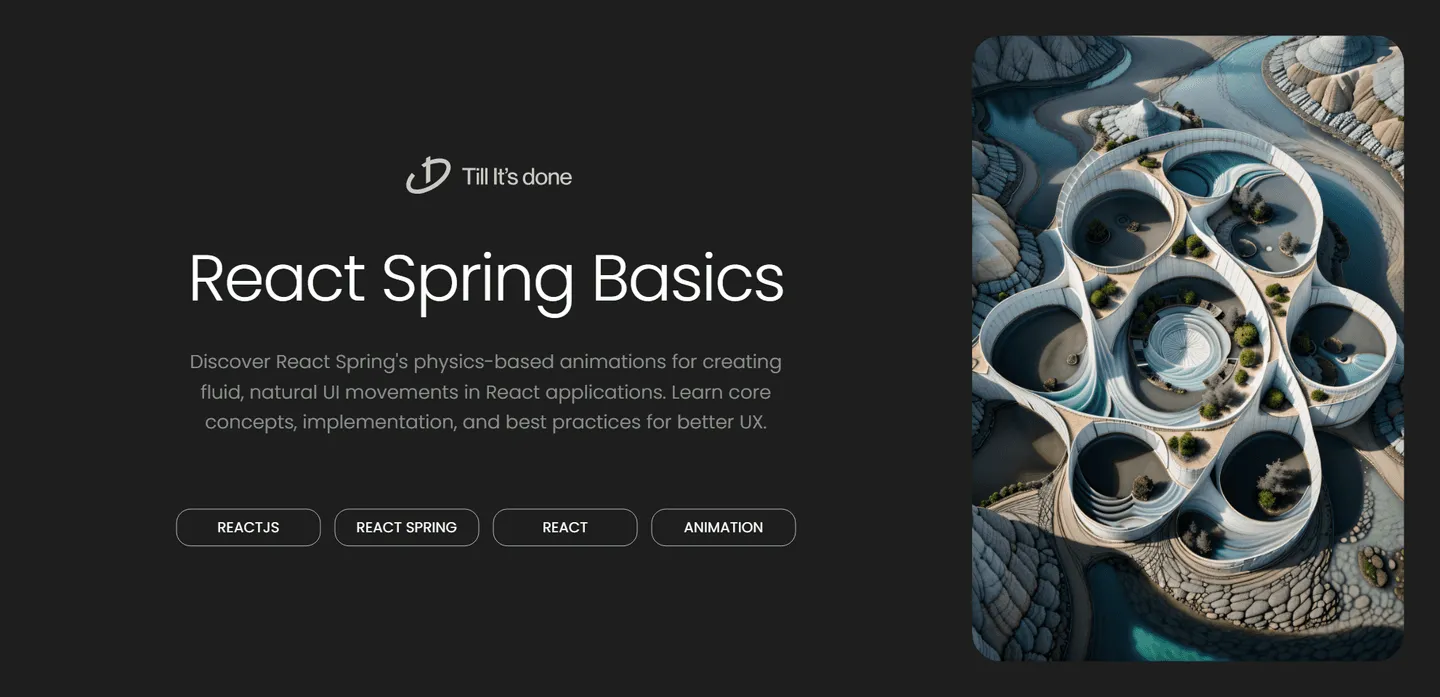- Services
- Case Studies
- Technologies
- NextJs development
- Flutter development
- NodeJs development
- ReactJs development
- About
- Contact
- Tools
- Blogs
- FAQ
Introduction to React Spring: Animation Guide
Learn core concepts, implementation, and best practices for better UX.

Introduction to React Spring: A Beginner’s Guide

React Spring has revolutionized the way we think about animations in React applications. Unlike traditional CSS animations, React Spring brings physics-based animations that feel more natural and intuitive. Think of it as giving your UI elements the same properties as real-world objects – they can bounce, spring, and move with realistic momentum.
Why React Spring?
The beauty of React Spring lies in its simplicity and power. Traditional animations often feel rigid and mechanical, but React Spring introduces a natural flow that mirrors real-world physics. When you push a real spring, it doesn’t just move linearly – it oscillates, gradually settling into its final position. React Spring brings this same natural behavior to your web applications.

Getting Started
Setting up React Spring in your project is straightforward. First, you’ll need to install it:
npm install @react-spring/webThe most fundamental concept in React Spring is the useSpring hook. This hook transforms values into animated values. Here’s a simple example:
import { useSpring, animated } from '@react-spring/web'
function AnimatedBox() { const springs = useSpring({ from: { opacity: 0, transform: 'translateY(50px)' }, to: { opacity: 1, transform: 'translateY(0px)' }, })
return <animated.div style={springs}>Hello React Spring!</animated.div>}Core Concepts
React Spring is built around several core concepts that make animation creation intuitive and flexible:
- Springs: The fundamental building block that powers all animations
- Animated Components: Regular components wrapped with animation capabilities
- Config: Controls how animations behave (tension, friction, mass)

Advanced Usage
Once you’re comfortable with basic springs, you can explore more advanced features:
const [springs, api] = useSpring(() => ({ from: { x: 0 }, config: { tension: 280, friction: 60 }}))
// Later in your codeapi.start({ from: { x: 0, }, to: { x: 100, },})React Spring also provides powerful tools for chaining animations, creating transitions, and handling gestures. These features allow you to create complex, interactive animations that respond to user input in real-time.
Best Practices
- Always consider performance implications when animating properties
- Use the
configobject to fine-tune animation behavior - Consider using
useTrailfor staggered animations - Implement proper cleanup in useEffect when necessary
Remember, the key to great animations is subtlety. Not everything needs to bounce and spring – sometimes a simple fade or slide is more effective.

Conclusion
React Spring opens up a world of possibilities for creating engaging user interfaces. Its physics-based approach to animation makes your applications feel more polished and professional. As you continue exploring React Spring, you’ll discover that it’s not just about making things move – it’s about creating experiences that feel natural and intuitive to your users.
Start small, experiment often, and most importantly, have fun bringing your interfaces to life with React Spring!
 สร้างเว็บไซต์ 1 เว็บ ต้องใช้งบเท่าไหร่? เจาะลึกทุกองค์ประกอบ website development cost อยากสร้างเว็บไซต์แต่ไม่มั่นใจในเรื่องของงบประมาณ อ่านสรุปเจาะลึกตั้งแต่ดีไซน์, ฟังก์ชัน และการดูแล พร้อมตัวอย่างงบจริงจาก Till it’s done ที่แผนชัด งบไม่บานปลายแน่นอน
สร้างเว็บไซต์ 1 เว็บ ต้องใช้งบเท่าไหร่? เจาะลึกทุกองค์ประกอบ website development cost อยากสร้างเว็บไซต์แต่ไม่มั่นใจในเรื่องของงบประมาณ อ่านสรุปเจาะลึกตั้งแต่ดีไซน์, ฟังก์ชัน และการดูแล พร้อมตัวอย่างงบจริงจาก Till it’s done ที่แผนชัด งบไม่บานปลายแน่นอน  Next.js สอน 14 ขั้นตอนเบื้องต้น: สร้างโปรเจกต์แรกใน 30 นาที เริ่มต้นกับ Next.js ใน 14 ขั้นตอนเพียงแค่ 30 นาที พร้อม SSR/SSG และ API Routes ด้วยตัวอย่างโค้ดง่าย ๆ อ่านต่อเพื่อสร้างโปรเจ็กต์แรกได้ทันทีที่นี่
Next.js สอน 14 ขั้นตอนเบื้องต้น: สร้างโปรเจกต์แรกใน 30 นาที เริ่มต้นกับ Next.js ใน 14 ขั้นตอนเพียงแค่ 30 นาที พร้อม SSR/SSG และ API Routes ด้วยตัวอย่างโค้ดง่าย ๆ อ่านต่อเพื่อสร้างโปรเจ็กต์แรกได้ทันทีที่นี่  วิธีสมัคร Apple Developer Account เพื่อนำแอปขึ้น App Store ทีละขั้นตอน อยากปล่อยแอปบน App Store ระดับโลก มาอ่านคู่มือสมัคร Apple Developer Account พร้อมเคล็ดลับ TestFlight และวิธีอัปโหลดที่ง่ายในบทความเดียวนี้ได้เลย
วิธีสมัคร Apple Developer Account เพื่อนำแอปขึ้น App Store ทีละขั้นตอน อยากปล่อยแอปบน App Store ระดับโลก มาอ่านคู่มือสมัคร Apple Developer Account พร้อมเคล็ดลับ TestFlight และวิธีอัปโหลดที่ง่ายในบทความเดียวนี้ได้เลย  TypeScript Interface คืออะไร? อธิบายพร้อมวิธีใช้และข้อแตกต่างจาก Type เรียนรู้วิธีใช้ TypeScript Interface เพื่อสร้างโครงสร้างข้อมูลที่ปลอดภัยและเข้าใจง่าย พร้อมเปรียบเทียบข้อดีข้อแตกต่างกับ Type ที่คุณต้องรู้ ถูกรวมเอาไว้ในบทความนี้แล้ว
TypeScript Interface คืออะไร? อธิบายพร้อมวิธีใช้และข้อแตกต่างจาก Type เรียนรู้วิธีใช้ TypeScript Interface เพื่อสร้างโครงสร้างข้อมูลที่ปลอดภัยและเข้าใจง่าย พร้อมเปรียบเทียบข้อดีข้อแตกต่างกับ Type ที่คุณต้องรู้ ถูกรวมเอาไว้ในบทความนี้แล้ว  Material-UI (MUI) คืออะไร อยากสร้าง UI สวยงามและเป็นมืออาชีพในเวลาอันรวดเร็วใช่ไหม มาทำความรู้จักกับ Material-UI (MUI) ที่ช่วยให้คุณพัฒนาแอปพลิเคชันบน React ได้ง่ายและดูดีในทุกอุปกรณ์
Material-UI (MUI) คืออะไร อยากสร้าง UI สวยงามและเป็นมืออาชีพในเวลาอันรวดเร็วใช่ไหม มาทำความรู้จักกับ Material-UI (MUI) ที่ช่วยให้คุณพัฒนาแอปพลิเคชันบน React ได้ง่ายและดูดีในทุกอุปกรณ์  เปรียบเทียบ 3 วิธีติดตั้ง install node js บน Ubuntu: NVM vs NodeSource vs Official Repo แบบไหนดีที่สุด? เรียนรู้วิธีติดตั้ง Node.js บน Ubuntu ด้วย NVM, NodeSource หรือ Official Repo เลือกวิธีที่เหมาะกับความต้องการของคุณ พร้อมเปรียบเทียบ เพื่อการพัฒนาที่มีประสิทธิภาพ!
เปรียบเทียบ 3 วิธีติดตั้ง install node js บน Ubuntu: NVM vs NodeSource vs Official Repo แบบไหนดีที่สุด? เรียนรู้วิธีติดตั้ง Node.js บน Ubuntu ด้วย NVM, NodeSource หรือ Official Repo เลือกวิธีที่เหมาะกับความต้องการของคุณ พร้อมเปรียบเทียบ เพื่อการพัฒนาที่มีประสิทธิภาพ! พูดคุยกับซีอีโอ
We'll be right here with you every step of the way.
We'll be here, prepared to commence this promising collaboration.
Whether you're curious about features, warranties, or shopping policies, we provide comprehensive answers to assist you.


